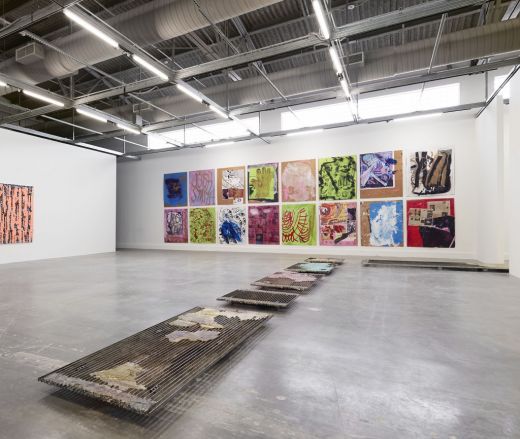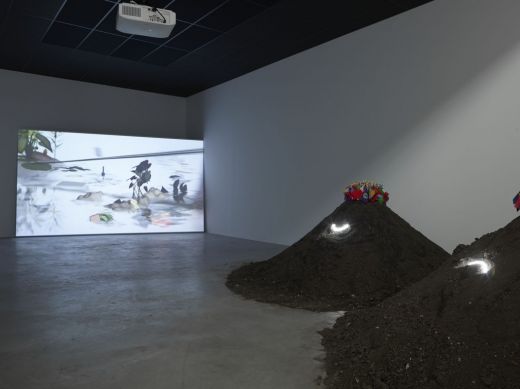
Love of Technology, Installation View, 2013, Foreground installation by Lena Henke, Background Josh Smith, Untitled 2012. Photo: Daniel Portnoy.
Museum of Contemporary Art, North Miami
Even those not haunted by dystopian technological nightmares may well have experienced the commonplace urge to both embrace and reject new technologies, and this exhibition encourages us to examine our relationship with technology by addressing both our enthusiasm for new advances and fears that technology will replace us. An artistic preoccupation since at least World War I, the specific starting point for this consideration of technology is French sociologist and anthropologist Bruno Latour’s book Aramis, or the Love of Technology (1993), a “scientifiction” hybrid constructed from fact and fiction which examines the failed development of a new personal mass transit system in Paris during the 1970s and 1980s. Regardless of the viewer’s familiarity with the Aramis project or Latour’s book, it quickly becomes apparent that the exhibition’s title Love of Technology is not intended to be taken literally. Ambivalence Towards Technology might be more apt.
Most of the pieces included in Love of Technology date from the last three years, with the exception of Argentinean architect and artist Luis Fernando Benedit’s works from the 1970s. His beautifully rendered pencil and watercolor works depict articulated mechanical creatures, and are displayed alongside designs for prototype labyrinths. One of these labyrinths, housing shivering white mice, is included in the exhibition, although its purpose and significance is not entirely clear.
A number of other works also display a strong engagement with the technological theme. The inclusion of Andrea Zittel’s “Aggregated Stacks” (2012) and several other pieces is and welcoming. Similarly apposite is the work that opens the exhibition by Berlin-based artist Oliver Laric. His video “Versions” (2010-2012) is presented in two different forms in recognition of the artist’s continual re-working of his material, referencing the (presumably Benjaminian) idea of the overthrow of the original in the age of mechanical, and now digital, reproduction. Ian Cheng’s work “Thousand Islands Thousand Laws” (2013), which rounds off the show, resonates with Laric’s pieces since it is designed to evolve in perpetuity. Because of Cheng’s programming, the military-looking avatar of this threatening and slyly humorous work is destined to spend eternity as part of an ever-changing narrative involving rogue herons, a dinosaur, a jet ski, some office chairs, and who knows what else.

Love of Technology, Installation View, 2013, right Jack Strange, Good Haircut, Bad Haircut, 2011 left Ian Cheng,Thousand Islands Thousand Laws, 2013 PHOTO Daniel Portnoy
Utilizing a completely different approach, Calla Henkel and Max Pitegoff’s work explores the seemingly unstoppable rise of Berlin’s techie start-ups through a combination of text and photographs. The article length text (which, like Latour’s book, may be a conflation of fiction and fact) is screwed onto the gallery wall and interspersed by photographs taken in various companies’ offices. Henkel and Pitegoff’s first-person text attempts to provide both an intimate impression and a broader view of the preponderance of small organizations based in Berlin who aim to get rich producing apps and other technological intangibles. In the text, the artists seem ambivalent towards their subject matter, and their photographs reinforce this sense of detachment.
Nearby, a sculptural “runway” created by Lena Henke, another artist based in Germany, intersects the gallery, cutting through a wall into the neighboring space. This runway is strictly intended for viewing, not to be walked on, since each piece of grating has been encrusted with various different colored materials including epoxy, glass, and concrete. A pervasive metallic scraping sound, issuing from Morag Keil’s “Sex Machine” (2011), backgrounds the viewer’s experience in this section of the space. Perhaps ultimately the fear is that, like Keil’s machine thrusting into nothingness, our relationship with technology is no more resolved or productive now than when the Aramis project failed to reach fruition more than thirty years ago.










